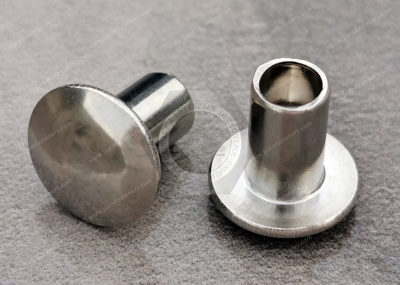Call Us
+86 136 6007 9809
Call Us
+86 136 6007 9809
Oct. 22, 2024
Rivets are standard connectors in the shipbuilding process and are widely used in shipboard connections, lap joints, reinforcement, and so on. The types of rivets vary according to different connection methods and structural characteristics. Typical rivets include standard, flare, multi-cap, and double-head rivets.
Generally speaking, the materials used for rivets are probably the following types:
1. Aluminum rivets: mainly made of aluminum and the production of rivets.
2. Stainless steel rivets: mainly made of stainless steel and the production of rivets.
3. Alloy rivets: mainly made of alloy and the production of rivets.
4. Plastic rivets: mainly made of plastic and the production of rivets.
5. Copper rivets: These are mainly copper-based materials used in rivet production. Copper can be divided into T2, T3, T4, and other grades.
6. Iron rivets: mainly iron material-based and the production of rivets. The iron material is divided into 1006, 1008A, Q235, 1T, and other grades.
Aluminum Flush-Mount Solid Rivets
18-8 Stainless Steel Flush-Mount Solid Rivets
Brass Flush-Mount Solid Rivets
Steel Flush-Mount Solid Rivets
Steel Domed Head Solid Rivets
Aluminum Domed Head Solid Rivets
18-8 Stainless Steel Domed Head Solid Rivets
Brass Domed Head Solid Rivets
Copper Domed Head Solid Rivets
18-8 Stainless Steel Flat Head Solid Rivets
Steel Flat Head Solid Rivets
The rivet head diameter


Rivet head diameter is one of the critical parameters of rivets, with a standard of 6-50mm. Generally, the head diameter of the rivet is about 1.5 times the length of the rivet. If you need a higher connection strength, the rivet head diameter will be increased accordingly.
Rivet length
Rivet length is another important parameter, with a general length between 20 and 300mm. To achieve the best connection, choose rivets of different lengths for other connectors.
The characteristics of rivets
Different types of rivets have their distinct characteristics. For example, ordinary rivets are suitable for single-layer boards, thin boards, or bulkhead connections, and the connection is simple, safe, and reliable; flare rivets are ideal for frame connection, with higher connection strength and better seismic capacity.
Riveting technology notes
Riveting technology is a vital part of the shipbuilding process and needs to operate by professional standards to ensure the quality and safety of the connection. Specifically, attention needs to be paid to the following aspects:
1, choose the right type and specification of rivets;
2, the gap between the rivet head and the drilling needle can not be too large or too small. Otherwise, the connection effect will be affected;
3, the installation of rivets should be uniform force; too much or too little strength may affect the quality of the connection;
4, after installation, it must be checked and tested to ensure that the quality of the connection meets the standard.
The size of rivets used in marine engineering varies, and choosing the appropriate type and specification is necessary according to the actual needs. Understanding the characteristics and precautions of different rivets can help ship engineers improve work efficiency and quality. At the same time, the riveting process of the ship must be carried out in strict accordance with the operating procedures to ensure the quality and safety of the ship connection.
If you are looking for high-quality steel rivets and fasteners or technical support for structural design, please get in touch with me. Thanks.Email:adelajonly@gmail.com
Website: https://www.juxinfasteners.com
Previous: Steel Domed Head Solid Rivets
Contact Us
Tel.:
+86 020 8621 0320
+86 020 3121 6067
Technical Support:
Navigation
SEND INQUIREY